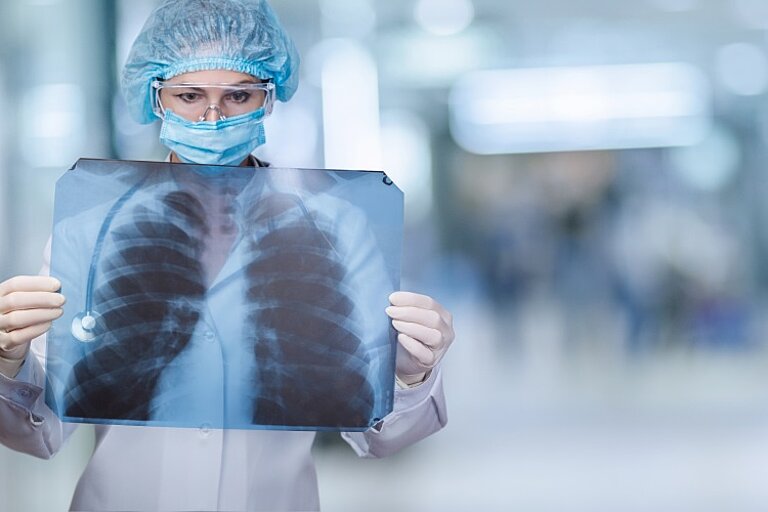Publications
19.03.2020
Use of medical technology can be life-saving for COVID-19 patients
The fight against the further spread of the coronavirus Sars-CoV-2 and the lung disease COVID-19 confronts the healthcare system with new challenges. One of the strengths of medical technology is early detection, rapid and accurate diagnosis of diseases and monitoring of the treatment process. But even more important are the measures of acute therapy. Medical devices for therapy and support of treatments make a valuable contribution to the recovery of COVID-19 patients, especially in these challenging times.

A major consequence of the virus infection is respiratory distress in patients. The virus can therefore quickly become life-threatening, especially for older people and people with previous illnesses. For people with severe respiratory diseases, the focus is thus on ventilators, as well as on diagnostic imaging recommended by the German Society for Intensive Medical Care (DGIIN), which plays a significant role in the continuous monitoring of the disease.
Respiratory equipment
The virus can cause both unilateral and bilateral pneumonia. Patients with particularly severe COVID-19 pneumonia are invasively ventilated in the intensive care unit to counteract lung failure. During the inspiration phase, the ventilator blows respiratory gas with pressure into the lungs. The air then escapes in the expiratory phase and the pressure drops. In order not to overstretch the sensitive tissue of the lungs, the pressure and volume of the oxygen are individually adjusted. The pressure prevents the lung from collapsing during the expiration phase. This makes ventilators the most important measure in the treatment of pneumonia, which can be triggered by coronavirus.
Computer tomography systems
As the situation in other countries shows, computed tomography systems (CT scanner) are also used to monitor these critically ill patients with acute lung failure and to ensure appropriate therapies (continuous monitoring). In the intensive care treatment of ventilated patients, a whole range of relevant indications for the use of CTs must be considered, e.g. respiratory complications such as misplaced catheters, pneumothorax, pneumomediastinum, secondary infections, empyema and effusions, etc.
Low dose CT ist an important additional diagnostic tool to identify patients who show symptoms of COVID-19 but for whom a laboratory test was negative. In this case, an X-ray image is taken with minimal radiation dose, which is only 10-30 percent of a normal CT of the chest. The low dose CT scanner can be used to detect whether a viral pneumonia is present. Whether the viral infection was caused by SARS-Cov-2, influenza or another virus cannot be detected here at present and therefore does not replace the laboratory test. However, it can ensure that a lung disease is not overlooked in patients under certain conditions. Patients can therefore be ventilated and receive intensive medical care as early as possible in order to counteract the rapid progression of the disease.
Blood Gas Systems
However, the increased demand for ventilation systems not only entails a corresponding capacity of CT systems, but also an increased need for blood gas systems to monitor ventilation patients. These systems are used to monitor lung function in respiratory diseases such as those caused by SARS-CoV-2. It can lead to serious pulmonary complications. For example, hypoxaemia, hypercapnia or a mixture of both can be measured by blood gas analysis systems and the therapy can be adjusted to the individual patient. Blood gas systems can also be used to clarify inflammation and incipient sepsis.
X-ray systems (thorax)
Classical x-rays - primarily for imaging the thorax - are also used as a supplement throughout the entire care process for patients. In particular, the ACR (American College of Radiology) recommends mobile devices for this purpose, which reduce the risk of infection because there is no need to transport patients and are easier to disinfect.
Ultrasound systems
Experiences in other countries as well as current recommendations for intensive care therapy of patients with COVID-19 (Kluge et al, March 2020) show that the use of ultrasonic devices at the bedside may also be indicated, especially for patients at risk. These devices should also be available wherever infected citizens and patients are treated.
In order to be able to react to the further spread of the coronavirus, joint action by all players is needed. Our task now is to ensure the availability of the equipment. In this context, ZVEI is also supporting the establishment of a nationwide database for ventilation stations, which was set up to prepare for a possible increase in the number of seriously ill corona patients and to show doctors where there is free capacity. (www.divi.de/intensivregister).
******************
If you have questions about COVID-19, please refer to the following pages:
Recommendations for intensive care therapy of patients with COVID-19: https://link.springer.com/article/10.1007/s00063-020-00674-3
Information of the BzGA for citizens: https://www.infektionsschutz.de/coronavirus-sars-cov-2.html
All information for the professional public, including case numbers and recommendations: https://www.rki.de/DE/Content/InfAZ/N/Neuartiges_Coronavirus/nCoV.html
The Federal Ministry of Health coordinates all activities for the Federal Government: On the Ministry's website you will find up-to-date information on the situation in Germany: www.bundesgesundheitsministerium.de/coronavirus.html
Advice on infection prevention and further information on this can be found on the website of the Federal Centre for Health Education: https://www.bzga.de/
